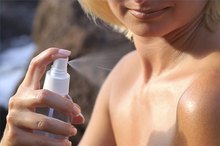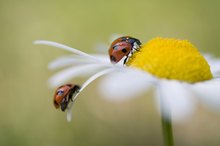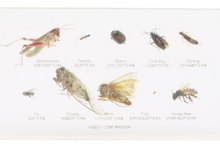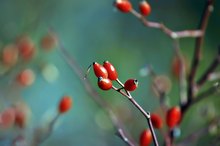How to Apply Neem Oil
Plant-based remedies have been used since human beings first evolved to walk upright and are still favored in medicinal systems such as ayurveda and Chinese herbal medicine. While many alternative medicines, such as homeopathic remedies, have not been proven scientifically to work, neem oil seems to be the real deal.
Every part of the neem tree, from the roots to the flower, can be used.
The tree is commonly referred to as "the village dispensary" in India, and its Sanskrit name is Arishtha, which means "reliever of sickness." Neem oil is used both topically and internally, depending on which part of the plant has been processed.
Applying neem oil is not difficult — but as with any new medication or remedy, it is wise to do a small patch test to make sure you are not sensitive to it.
Facts About Neem Oil
Neem oil is generally cold pressed from the berries of the neem tree (Azadirachta indica), which grows in Africa, Asia and other subtropical locations around the world. In India, the neem tree is commonly called the toothbrush tree.
A member of the mahogany family, neem trees are evergreens with wide, flat leaves. They bear small fruits that are roughly the size of an olive and made up of between 10 and 30 percent oil.
Neem oil contains substances that are:
- Antibacterial
- Fungicidal
- Insecticidal
The most potent compound in neem oil is called azadirachtin, explain the experts at Oregon State University 1. It is extremely complex, which makes it very valuable as a pesticide — insects cannot adapt to it as they do with a simpler substance.
- Neem oil is generally cold pressed from the berries of the neem tree (Azadirachta indica), which grows in Africa, Asia and other subtropical locations around the world.
How Neem Oil Works
How to Use Cedar Oil as an Insect Repellent
Learn More
Azadirachtin works in several different ways, including repelling insects, sterilizing them, stopping them from laying eggs and even killing them. It is, for example, lethally toxic to aphids, caterpillars and termites.
Neem oil has a very low toxicity for human beings and other mammals, however. According to a February 2017 article published in the Palestinian Medical and Pharmaceutical Journal, neem twigs have been historically used in India to clean teeth, while the leaves are a popular treatment for both eye infections and acne.
Aside from topical uses, the leaves of the neem tree, which is also called Persian lilac, are often steeped in hot water to make a tisane. The resulting decoction is used to stimulate the appetite, ease headache pain, treat the symptoms of malaria and as a diuretic to alleviate water retention.
- Azadirachtin works in several different ways, including repelling insects, sterilizing them, stopping them from laying eggs and even killing them.
- Aside from topical uses, the leaves of the neem tree, which is also called Persian lilac, are often steeped in hot water to make a tisane.
- The resulting decoction is used to stimulate the appetite, ease headache pain, treat the symptoms of malaria and as a diuretic to alleviate water retention.
How to Use Neem Oil for Skin
Aside from its antibacterial and fungicidal properties, neem oil is also high in vitamin E and essential fatty acids, say the clear skin enthusiasts at Biome 5. Neem oil is high in natural triglycerides as well, in addition to containing antimicrobial and anti-inflammatory properties.
The antibacterial effects of neem oil can be used to treat acne, eczema, psoriasis and scabies, while its insecticidal properties have traditionally been used to treat head lice. The fungicidal compounds are useful in eliminating athlete's foot and ringworm.
How you apply neem oil to your skin depends on what kind of neem oil you have.
The simplest way is to purchase products that contain neem oil and are formulated for specific uses — such as toothpaste, shampoo, conditioner, cleansers and lotions. These can be used as directed on their labels. You can also add a few drops of neem oil to small portions of your regular shampoo, cleanser or moisturizer, as long as you use it immediately.
- Aside from its antibacterial and fungicidal properties, neem oil is also high in vitamin E and essential fatty acids, say the clear skin enthusiasts at Biome.
- You can also add a few drops of neem oil to small portions of your regular shampoo, cleanser or moisturizer, as long as you use it immediately.
How to Use Pure Neem Oil
How to Use Clove Oil as an Insect Repellent
Learn More
Use a cotton ball, cotton pad, cotton swab or clean fingertips to massage the oil into your skin.
Wash your hands thoroughly afterward, especially if you have mixed your neem oil with camphor or peppermint oil, because they can sting like crazy if you get them in your eyes.
Read more: What Causes Cheek Acne?
Using Neem Oil for Pets
For your furry friends, neem oil's antibacterial, antifungal, insecticidal and anti-inflammatory properties can soothe rashes and irritated skin as well as help take the itch out of insect bites and kill fleas. You should dilute neem oil with a carrier oil and do a test spot on your dog before treating his whole body.
According to the pet lovers at The Labrador Site, neem oil is toxic to dogs at a concentration of 200 milligrams per kilogram of body weight, which is about 2.2 pounds 4.
They suggest diluting it at a ratio of 1 part neem oil to 10 parts carrier oil. Olive oil works well as a carrier oil, but coconut oil will solidify if it is not warmed in the sun or in your hands.
Mix just enough for one day's use and massage it into your dog's skin wherever it is itchy or chafed.
Do this twice per day to start and then once a day as the skin clears up. Dogs should not ingest neem oil, but the smell usually puts them off.
- For your furry friends, neem oil's antibacterial, antifungal, insecticidal and anti-inflammatory properties can soothe rashes and irritated skin as well as help take the itch out of insect bites and kill fleas.
- They suggest diluting it at a ratio of 1 part neem oil to 10 parts carrier oil.
How to Use Neem Oil on Dogs
Create a neem oil shampoo by adding a few drops of your diluted neem oil mixture to unmedicated shampoo at a 1-to-10 ratio. Again, only mix enough for each use, because neem oil will start to break down after only eight hours.
Mix a neem oil spray to help control fleas and keep your dog's skin supple and moist.
Put one part diluted neem oil and 10 parts water into a spray bottle. Add a few drops of dish detergent to act as an emulsifier. Place the top on and secure it, then shake the mixture gently to thoroughly mix the ingredients.
- Create a neem oil shampoo by adding a few drops of your diluted neem oil mixture to unmedicated shampoo at a 1-to-10 ratio.
- Add a few drops of dish detergent to act as an emulsifier.
Neem Oil and Cats
Neem oil is not recommended for cats, warn the animal lovers at The Happy Cat Site 9. Cats groom themselves more thoroughly than dogs do by licking themselves, which means they will ingest any neem oil that you put on their skin.
If you must use neem oil on your cat, purchase products that are formulated specifically for cats; do a spot test on her skin, and then use the smallest recommended dosage 9. Do not use any neem oil product that contains tea tree oil on cats, as it is toxic to felines.
- Neem oil is not recommended for cats, warn the animal lovers at The Happy Cat Site.
- If you must use neem oil on your cat, purchase products that are formulated specifically for cats; do a spot test on her skin, and then use the smallest recommended dosage 9.
Neem Oil Use in Gardening
Neem oil for garden use is the perfect solution for gardeners who wish to avoid toxic, chemical-based pesticides that can harm bees and other beneficial insects.
Because it must be ingested to be toxic to insects, it will not harm bees, as the experts at Mercola assure. It is also nontoxic to birds, but will harm or kill fish and other aquatic life.
The gardening authorities at Epic Gardening agree, offering reassurance that neem oil does not harm butterflies or ladybugs, either 8. It has been shown to encourage earthworm activity, which is helpful in aerating your soil.
Neem oil is biodegradable and breaks down within about eight hours, so there is no danger of it contaminating ground water. You can purchase gardening solutions that contain neem oil, or you can mix your own.
- Neem oil for garden use is the perfect solution for gardeners who wish to avoid toxic, chemical-based pesticides that can harm bees and other beneficial insects.
- It has been shown to encourage earthworm activity, which is helpful in aerating your soil.
How to Make Neem Oil Pesticide
Neem oil will not mix with water, so you need an emulsifier such as insecticidal soap to make an effective neem oil for plants.
Add about 1/3 teaspoon of insecticidal soap to 1 quart of warm water, and mix. Add 1 teaspoon of neem oil slowly, swirling the container to mix it well.
Spray your plants carefully, making sure to get the tops and bottoms of the leaves, as well as the places where leaves meet the stems and the undersides of blossoms — bugs like to hide in tight little spaces.
You can increase the amount of neem oil spray if need be, but make sure to use it right away before it breaks down. Use this strength on plants and in the soil around them once every two weeks to keep your garden pest free and to discourage nematodes.
- Neem oil will not mix with water, so you need an emulsifier such as insecticidal soap to make an effective neem oil for plants.
- Use this strength on plants and in the soil around them once every two weeks to keep your garden pest free and to discourage nematodes.
How to Use Neem Oil on Plants
If your garden is already infested, make a stronger solution by mixing 4 gallons of water, 5 teaspoons of insecticidal soap and 6.5 ounces of pure neem oil. Spray your plants thoroughly once every week to combat the infestation, and then switch to the lighter concentration and spray them every two weeks to keep them clear of unwanted bugs.
Neem oil is safe for use on indoor plants and in greenhouses. You may also purchase neem oil cakes, which are the byproduct of cold-pressing neem oil. These can be crumbled into the soil around your plants to protect them from pests and to nourish the soil.
- If your garden is already infested, make a stronger solution by mixing 4 gallons of water, 5 teaspoons of insecticidal soap and 6.5 ounces of pure neem oil.
- Spray your plants thoroughly once every week to combat the infestation, and then switch to the lighter concentration and spray them every two weeks to keep them clear of unwanted bugs.
Tips for Using Neem Oil
Neem oil, like coconut oil, can become solid at room temperature.
Do not microwave either oil because it can break them down. Set the oil container in a windowsill or in a warm place, such as on top of your refrigerator, or simply warm the container by rolling it slowly back and forth between your palms the way you would a brandy snifter.
Neem oil is also used as a spermicide, according to WebMD, but it does not protect against sexually transmitted diseases 3.
- Neem oil, like coconut oil, can become solid at room temperature.
Things to Be Aware Of
Neem oil should not be used on babies, children, pregnant women or breastfeeding mothers. It will stain fabrics, so if you treat your dogs with it, keep them off the furniture until the neem oil has thoroughly dried.
**Do not ingest neem oil intended for topical use.
This type is made from the berries of the neem tree, while neem products intended for internal use are made from the leaves. They are not interchangeable. **
Read more: Side Effects of Neem Oil
- Neem oil should not be used on babies, children, pregnant women or breastfeeding mothers.
- It will stain fabrics, so if you treat your dogs with it, keep them off the furniture until the neem oil has thoroughly dried.
Related Articles
References
- Oregon State University: OSU Extension Service: Profiles of Organic Pesticides
- Palestinian Medical and Pharmaceutical Journal: A Review of Chemical Constituents and Traditional Usage of Neem Plant (Azadirachta indica)
- WebMD: Neem
- The Labrador Site: Neem Oil For Dogs – What Does It Really Do?
- Biome: 3 Ways Neem Oil Will Improve Your Skin With Regular Use
- Mercola: Neem Oil May Be Beneficial for Medicinal and Agricultural Uses
- CureJoy: 6 Health Benefits and Uses of Neem Oil for Skin, Hair, and Health
- Epic Gardening: 20+ Neem Oil Uses in the Garden and Beyond
- The Happy Cat Site: Is Neem Oil for Cats Really Effective?
- Jalaluddin M, Rajasekaran UB, Paul S, Dhanya RS, Sudeep CB, Adarsh VJ. Comparative Evaluation of Neem Mouthwash on Plaque and Gingivitis: A Double-blind Crossover Study. J Contemp Dent Pract. 2017;18(7):567-571. doi:10.5005/jp-journals-10024-2085
- Pai MR, Acharya LD, Udupa N. Evaluation of antiplaque activity of Azadirachta indica leaf extract gel--a 6-week clinical study. J Ethnopharmacol. 2004;90(1):99-103. doi:10.1016/j.jep.2003.09.035
- Almas K. The antimicrobial effects of extracts of Azadirachta indica (Neem) and Salvadora persica (Arak) chewing sticks. Indian J Dent Res. 1999;10(1):23-6. doi:10865390
- Maity P, Biswas K, Chattopadhyay I, Banerjee RK, Bandyopadhyay U. The use of neem for controlling gastric hyperacidity and ulcer. Phytother Res. 2009;23(6):747-55. doi:10.1002/ptr.2721
- Paul R, Prasad M, Sah NK. Anticancer biology of Azadirachta indica L (neem): a mini review. Cancer Biol Ther. 2011;12(6):467-76. doi:10.4161/cbt.12.6.16850
- Abiy E, Gebre-michael T, Balkew M, Medhin G. Repellent efficacy of DEET, MyggA, neem (Azedirachta indica) oil and chinaberry (Melia azedarach) oil against Anopheles arabiensis, the principal malaria vector in Ethiopia. Malar J. 2015;14:187. doi:10.1186/s12936-015-0705-4
Writer Bio
Emmy-award nominated screenwriter Brynne Chandler is a single mother of three who divides her time between professional research and varied cooking, fitness and home & gardening enterprises. A running enthusiast who regularly participates in San Francisco's Bay to Breakers run, Chandler works as an independent caterer, preparing healthy, nutritious meals for Phoenix area residents.









